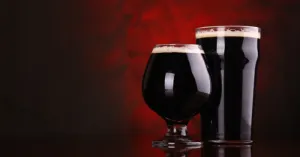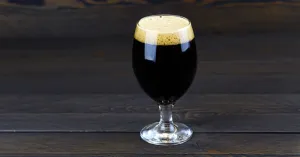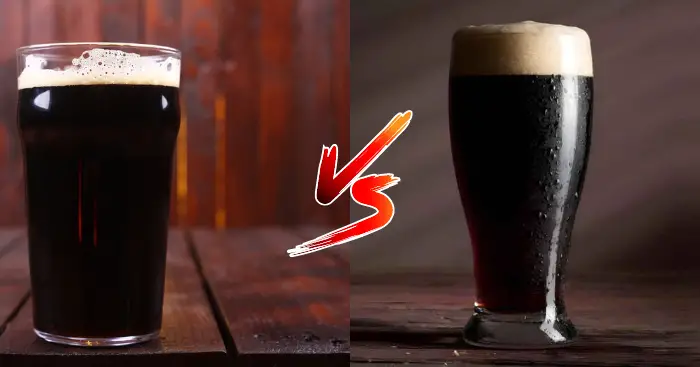When it comes to craft beer, dark ale vs. stout is a common comparison. Both beers are considered some of the most popular and flavorful, with their distinct tastes, colors, alcohol content, and calorie counts.
But what exactly sets them apart? Let’s dive into the history behind each one to gain insight into how they differ from each other and discover why these two types of brews have become such beloved staples amongst avid beer drinkers worldwide.
We’ll also explore examples of popular dark ales and stouts so you can pick your favorite!
Table of Contents:
- History of Dark Ale and Stout Beers
- Brewing Process for Dark Ale and Stout Beers
- Taste, Color, Alcohol Content, and Calorie Content of Dark Ale and Stout Beers
- Popular Examples of Dark Ale Beers Around the World
- Popular Examples of Dark Ale and Stout Beers Around the World
- Conclusion on the Difference between Dark Ale vs Stout Beer
- FAQs in Relation to Dark Ale vs Stout
- Conclusion
History of Dark Ale and Stout Beers

The origin of dark ale can be track down back to the Middle Ages when brewers began experimenting with different ingredients and techniques. Dark ales were first brewed in England, becoming popular due to their rich flavor and aroma.
The earliest known dark ales were made from malted barley, hops, yeast, and water. Over time, other ingredients, such as roasted grains and spices, were added for additional flavor.
Stout beer is a type of dark ale that originated in Ireland during the 1700s. It was originally called “stout porter” because it was stronger than traditional porters at the time.
Dark ales and stouts have a long history of brewing, with origins dating back to the Middle Ages.
This article will detail the differences between these two popular beer styles by looking at their unique ingredients and brewing processes.
Brewing Process for Dark Ale and Stout Beers

Dark ales and stouts are two popular types of beer that have been around for centuries. While they may look similar, each type has some key differences in the brewing process.
Ingredients Used in Dark Ale Brewing
The ingredients used to make dark ale include malted barley, hops, yeast, and water. Other grains, such as wheat or oats, can also be append depending on the recipe to give the beer a unique flavor. Hops provide bitterness, while malted barley gives dark ales their characteristic color and body. Yeast is responsible for fermentation which helps create alcohol content and carbonation levels in the finished product.
Ingredients Used in Stout Beer Brewing
Stouts are brewed with similar ingredients as dark ales but typically use more roasted malt than lighter beers. It gives them a darker color and richer flavor profile than other beer styles like lagers or pilsners. Other common additions to stout recipes include coffee beans, chocolate malt, oatmeal, molasses, brown sugar, and spices like cinnamon or nutmeg for additional complexity of flavors.
Dark Ale vs Stout: Difference in Brewing Process
The main difference between these two beers is how long they boil the wort (the liquid extracted from mashing grain) before adding yeast to ferment it into alcohol. Dark ales boil for 30–60 minutes, while stouts boil for 1-2 hours, depending on the recipe. Stouts have a distinct flavor because brewers add coffee beans, cocoa nibs, spices, and other ingredients throughout the brewing process.
Dark ales and stouts have some similarities in their brewing processes, but also differ in the ingredients used and the resulting taste, color, alcohol content, and calorie content.
Let’s take a closer look at these differences between dark ales and stouts.
Taste, Color, Alcohol Content, and Calorie Content of Dark Ale and Stout Beers

Taste Differences Between Dark Ales and Stouts
The main difference between dark ales and stouts is the taste. Dark ales tend to have a sweeter, maltier flavor with notes of caramel or chocolate. Stouts are bitter, toasty, and earthy in flavor with hints of coffee or licorice. The bitterness level can also be higher than in dark ales due to the use of hops during brewing.
Color Differences Between Dark Ales and Stouts
The color difference between dark ales and stouts is quite noticeable. Dark ales range from light amber to deep brown, while stouts tend to be darker shades of black or brown depending on how they brew.
Additionally, the head of a stout will be darker than a dark ale due to its higher roasted malt content.
Alcohol Content Differences Between Dark Ales and Stouts
The alcohol content also varies between these two types of beer. Most dark ales will have an alcohol by volume (ABV) ranging from 4-7%, while most stouts will have an ABV ranging from 5-9%. Although they may look similar in appearance, their strength can vary significantly depending on the type of beer you choose.
It means that drinking one stout beer could contain twice as much alcohol as one dark ale beer, so it’s important for drinkers to pay attention when selecting which type they would like to consume.
Calorie Content Differences Between Dark Ales and Stouts
There is also a difference in calorie content between these two types of beers. On average, a 12 oz serving of dark ale contains around 150 calories. In contrast, the same size serving of stout has about 180 calories due to its higher alcohol content which adds additional calories per ounce consumed.
Dark ales and stouts vary in taste, color, alcohol, and calorie content. Now let’s explore some of the most famous examples of dark ale and stout beers worldwide.
Popular Examples of Dark Ales Around the World
Dark ales are a type of beer that has been around for centuries. They have a dark color and rich flavor, often with roasted malt, coffee, chocolate, or caramel notes.
Some famous examples include Guinness Draught from Ireland, Negra Modelo from Mexico, Newcastle Brown Ale from England, and Samuel Adams Boston Lager from the United States. Each unique characteristic makes it stand out in its respective region or country.
Popular Examples of Stouts Around the World
Stout beers are similar to dark ales but tend to be even darker in color and fuller-bodied in flavor. Famous examples include Guinness Extra Stout from Ireland, Anchor Porter from the United States, Murphy’s Irish Stout from Ireland, and Young’s Double Chocolate Stout from England.
These stouts offer an intense experience with flavors such as espresso beans or chocolate mixed with roasted malts for an unforgettable taste sensation.
Dark ales and stouts are two of the world’s most popular types of beer, each offering its unique flavor profile.
This article explored some of the best examples from around the globe. Now let’s dive deeper into understanding the difference between these two beers.
FAQs in Relation to Dark Ale vs Stout
Is Guinness a dark ale?
Yes, Guinness is a dark ale. It is a type of stout beer that has been brewed in Dublin, Ireland, since 1759. The dark color comes from the roasted barley used in its brewing process.
Its flavor profile includes notes of coffee and chocolate with a creamy texture and dry finish. Guinness is one of the most popular beers around the world due to its unique taste and iconic branding.
What is considered a dark ale?
Dark ale is a beer brewed with roasted malts, resulting in a darker color and fuller flavor. Dark ales characterize by their malty sweetness and hints of chocolate or coffee and often have higher alcohol content than lighter beers. Depending on the malt used during brewing, they can range from golden brown to nearly black. Common examples include porters, stouts, bocks, and Schwarzer.
Conclusion
In conclusion, both have a long history, with dark ales originating in England during the Middle Ages and stouts developed from porters in Ireland during the 18th century.
Famous examples of both types of beer can be found worldwide, from Guinness Stout to Newcastle Brown Ale.
While stouts and dark ales share some similarities, many differences make them unique beers.
Both are flavoursome beers with a rich flavor profile, but stouts tend to be darker in color and higher in alcohol content than dark ales.
As far as alcohol content goes, Dark Ales generally range between 4%-6% ABV (alcohol by volume). In contrast, Stouts will typically fall within the 5%-9% ABV range but can reach upwards into double digits if desired by brewers or consumers alike.
Lastly, when it comes to calories, Dark Ales average around 150 per 12 oz serving while Stout’s clock in at about 200 per 12 oz serving which is due mainly because they are higher gravity beers containing more sugars than their light counterparts.
Ultimately, when it comes to choosing between dark ale and stout beer, it comes down to personal preference and taste!
Are you looking for the perfect beer to pair with your next meal? Are you a home brewer searching for new recipes and tips? Or are you curious about dark ales vs. stouts, their unique characteristics, and what makes them so special? Then look no further! Our blog is here to help.
We offer honest reviews of craft beers from around the world, helpful advice on brewing equipment and processes, subscription services that bring great brews right to your doorstep. Join us as we explore the wonderful world of craft beer!
Also Read: The Best Nutmeg Beer: Top 10

